文献阅读与翻译(精华版)
- 格式:pdf
- 大小:233.33 KB
- 文档页数:11
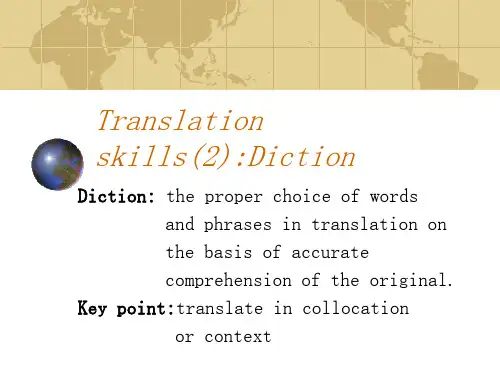
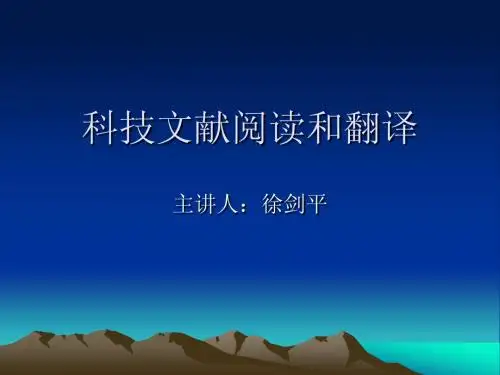
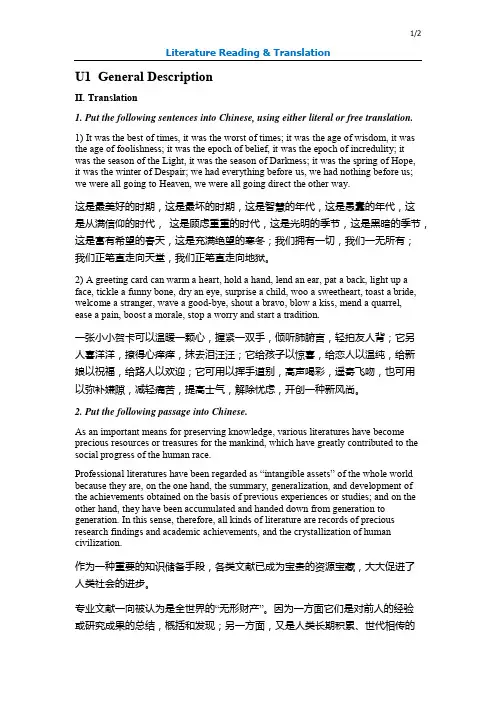
U1 General DescriptionII. Translation1. Put the following sentences into Chinese, using either literal or free translation. 1) It was the best of times, it was the worst of times; it was the age of wisdom, it was the age of foolishness; it was the epoch of belief, it was the epoch of incredulity; itwas the season of the Light, it was the season of Darkness; it was the spring of Hope,it was the winter of Despair; we had everything before us, we had nothing before us; we were all going to Heaven, we were all going direct the other way.这是最美好的时期,这是最坏的时期,这是智慧的年代,这是愚蠢的年代,这是从满信仰的时代,这是顾虑重重的时代,这是光明的季节,这是黑暗的季节,这是富有希望的春天,这是充满绝望的寒冬;我们拥有一切,我们一无所有;我们正笔直走向天堂,我们正笔直走向地狱。
2) A greeting card can warm a heart, hold a hand, lend an ear, pat a back, light up a face, tickle a funny bone, dry an eye, surprise a child, woo a sweetheart, toast a bride, welcome a stranger, wave a good-bye, shout a bravo, blow a kiss, mend a quarrel, ease a pain, boost a morale, stop a worry and start a tradition.一张小小贺卡可以温暖一颗心,握紧一双手,倾听肺腑言,轻拍友人背;它另人喜洋洋,撩得心痒痒,抹去泪汪汪;它给孩子以惊喜,给恋人以温纯,给新娘以祝福,给路人以欢迎;它可用以挥手道别,高声喝彩,遥寄飞吻,也可用以弥补嫌隙,减轻痛苦,提高士气,解除忧虑,开创一种新风尚。
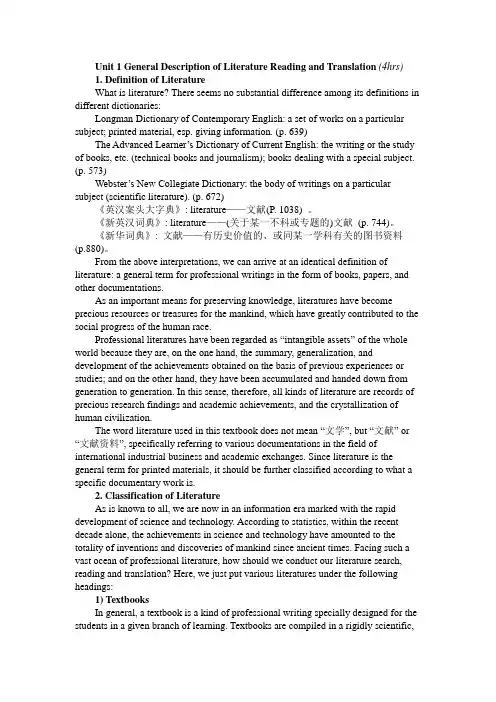
Unit 1 General Description of Literature Reading and Translation (4hrs)1. Definition of LiteratureWhat is literature? There seems no substantial difference among its definitions in different dictionaries:Longman Dictionary of Contemporary English: a set of works on a particular subject; printed material, esp. giving information. (p. 639)The Advanced Learner‟s Dictionary of Current English: the writing or the study of books, etc. (technical books and journalism); books dealing with a special subject. (p. 573)Webster‟s New Collegiate Dictionary: the body of writings on a particular subject (scientific literature). (p. 672)《英汉案头大字典》: literature——文献(P. 1038) 。
《新英汉词典》: literature——(关于某一不科或专题的)文献(p. 744)。
《新华词典》: 文献——有历史价值的、或同某一学科有关的图书资料(p.880)。
From the above interpretations, we can arrive at an identical definition of literature: a general term for professional writings in the form of books, papers, and other documentations.As an important means for preserving knowledge, literatures have become precious resources or treasures for the mankind, which have greatly contributed to the social progress of the human race.Professional literatures have been regarded as “intangible assets” of the whole world because they are, on the one hand, the summary, generalization, and development of the achievements obtained on the basis of previous experiences or studies; and on the other hand, they have been accumulated and handed down from generation to generation. In this sense, therefore, all kinds of literature are records of precious research findings and academic achievements, and the crystallization of human civilization.The word literature used in this textbook does not mean “文学”, but “文献” or “文献资料”, specifically referring to various documentations in the field of international industrial business and academic exchanges. Since literature is the general term for printed materials, it should be further classified according to what a specific documentary work is.2. Classification of LiteratureAs is known to all, we are now in an information era marked with the rapid development of science and technology. According to statistics, within the recent decade alone, the achievements in science and technology have amounted to the totality of inventions and discoveries of mankind since ancient times. Facing such a vast ocean of professional literature, how should we conduct our literature search, reading and translation? Here, we just put various literatures under the following headings:1) TextbooksIn general, a textbook is a kind of professional writing specially designed for the students in a given branch of learning. Textbooks are compiled in a rigidly scientific,systematic and logical way. Comparatively, the content of a textbook is mature and well established, because it has been compiled through the writer‟s careful selection, verification, discrimination, integration and comprehensive study of the subject. If you intend to acquire a general knowledge of a certain subject over a larger area, or if you want to have a preliminary understanding of a certain issue, you‟d better go over the relevant textbooks, which proves the best policy.2) MonographsA monograph is “an arti cle or short book on one particular subject or branch of a subject that the writer has studied deeply” (Longman Dictionary of Contemporary English, p. 704). It is also a “detailed scientific account, esp. a published report on some item of research” (The Advanced Learner‟s Dictionary of Current English, p. 632). The content of a monograph usually includes the history and present status of a particular subject, observed data, experimental methods and results, existing problems and the developing trend, various viewpoints and discussions of different schools of thought, research achievements and further exploration, and so on. A monograph usually functions as an important guide for the reader to understand the particular study comprehensively and deeply.3) PapersPapers are the most important and reliable sources for textbooks, monographs, and all the other documentary works. A complete paper is usually composed of the following elements: title, author, affiliation, abstract, keywords, introduction, theoretical analysis and/or experimental description, results and discussion or conclusion, acknowledgments, references, etc. (detailed description and exemplification of these elements in a professional paper are given in a separate textbook entitled Paper Writing and Publication, by Hu Gengshen, et al., Beijing: Higher Education Press, 2000.) A paper usually deals with a relatively specific topic, and with a comparatively narrow subject.4) EncyclopediasAn encyclopedia is “a book or set of books dealing with every branch of knowledge, or with one particular branch, in alphabetical order.” The difference between a dictionary and an encyclopedia is that “A dictionary explains words and an encyclopedia explains facts.” (Longman Dictionary of Contemporary English, p.361) As a basic reference book of generalized and summarized knowledge, an encyclopedia is usually compiled by many experts of many branches through many years. The contents of an encyclopedia, therefore, are comparatively mature and correct. It virtually serves as an important information retriever, providing comprehensive and systematic information about everything.The information retriever as such also includes yearbooks, dictionaries, guides, handbooks, and the like.5) PeriodicalsA periodical is a series of publications that appear at regular intervals. Periodicals are of various categories. From the perspective of names, for example, they are journals, acta, magazines, bulletins, rapid communications, letters, proceedings, records, abstracting services, reviews, indexes, etc., which constitute themain body of literature.Periodicals are characterized by being large in number and in variety, extensivein content and in circulation, mixed in language and in form, etc.Along with the rapid development of science and technology, periodicals have been rapidly increasing and have‟ been gradually professionalized, integrated and computerized.6) Special DocumentationThe so-called special documentation refers to all the printed materials that are non-books or non-periodicals. This special documentation mainly includes: standards, patent documents, trademarks, copyrights, contracts/agreements, reports, conference papers, dissertations (or theses), Product specifications, government publications, proposals, technical archives, electronic hypertexts, etc. Though neither books nor periodicals published regularly or publicly, the special documentation proves to be most effective resources for information retrieval. Insofar as literature search and reading are concerned, this kind of special documentation should not be overlooked. On the contrary, it calls for our special attention--that is why we have placed special emphasis on special documentation in the present textbook.Notes:1. journals, Acta, magazines, bulletins, rapid communications, letters, proceedings, records, abstracting services, reviews, indexes, etc. 会刊,学报,杂志,通报,快讯,通信稿,会议录,文献记录,世界文摘服务,评论,索引等2. hypertext 超级文本(指信息高速公路上的文件)3. Linguistic Features of Scientific LiteratureStylistically, literature is a kind of formal writing. Compared with an informal writing which usually utilizes an informal tone and colloquial language, a formal writing is a more serious approach to a subject of great importance and it avoids all colloquial expressions. Since the functions of scientific literature are to reveal creative research achievements, facilitate professional information retrieval, and help improve the development of science and technology, it deals objectively with the study of facts or problems; analyses on literature are based on relevant data, not on personal feelings, and discussions or conclusions are made on the basis of specific experiments or investigations.Syntactically, scientific literature has rigorous grammatical structures, and in most cases is rather unitary. Frequently used are indicative sentences, imperative sentences, complex sentences, and “It be + adj. (participle) + that ...” sentence patterns, etc.Morphologically, scientific literature is featured by high specialization, the use of technical terms and jargons, unambiguous implication and the fixed sense of the word. There are more compound words, Latin and Greek words, contracted words, noun clusters and so on in scientific literature than in other informational writing.Besides, non-verbal language is also very popular in various literatures such as signs, formulas, charts, tables, photos, etc. for the sake of accuracy, brevity, and clarity.Different literatures may have different linguistic features although they do havesimilar characteristics in common. The linguistic features of an individual literature will be discussed together with the specific category of documentation in the corresponding Unit of this textbook. To learn the linguistic features of various literatures will be beneficial not only to documentation reading but also to the translation and writing of such documentary works.4. Search for Relevant LiteratureThe search for relevant literature needed for professional study and research has become a practical skill for professionals. This is important because an effective way of literature search and reading will facilitate our information retrieval within a shorter period of time. In fact, everyone may have his/her own way of literature search and reading. And the following are some usual approaches:1) Global SearchBy “global search” we mean to search for materials around the subject in a larger dimension or within a wider range, i.e., conducting the extensive reading. For example:(1) Search for relevant books through the Classified and Specified Catalogues.(2) Search for periodicals through the Newspapers and Journals Indexing.(3) Search for domestic literature through the Domestic Sci-tech Data Catalogues.(4) Search for current foreign literature through the Sci-Tech Translation Bulletin.(5) Search for literature at home and abroad through INTERNET, WWW (World Wide Web), and other electronic retrieval means.2) Specific SearchBy “specific search” we mean to search for literature about a certain topic withina specific area or in a narrower scope. For example:(1) Select some most-related papers for intensive reading.(2) Expand the scope of the reading only on the basis of the references of the selected papers.(3) Try to find out relevant “reviews” on the topic so as to know the authoritative comments, the experts‟ views, the global developing trend and the general on-goings, etc.3) Processed SearchBy “processed search” we mean to accumulate and absorb essential information in the course of literature search and reading. For example:(1) Store the searched literature by careful note-taking and self-abstracting.(2) Sort out the searched documentation by timely putting them into different categories.(3) Digest/Absorb the searched information by creatively analyzing and synthesizing.It is very important to identify and then make generalization of the essential parts of the research papers, because the author of a paper should and must present his/her achievements or research findings through these parts. For this purpose, as a researcher, one has to be good at doing retrieval reading. By retrieval reading wemean retrospect reading of the manuscript in a very careful way so as to identify, register and generalize the gist or the main parts of work, or contributions we have made in a given paper. Literally, we mean reading the manuscript in a thorough manner and making notes: (1) as to the subjects dealt with, particularly subjects concerning with new information given incidentally; and (2) as to the new result and conclusive ideas reported. Material relating to each subject should then be gathered together in a logical way; and (3) all the sentences generalizing the main ideas of all the original materials should be put together so as to be well-versed, abstract-brief, condensed, complete, yet easily readable.In the final analysis, to digest and absorb useful information is the ultimate purpose of literature search and reading. This is a process of discarding the dross and selecting the essential, eliminating the false and retaining the true, proceeding from the easy to the difficult and from the outer to the inner. It is also a process of reading, selecting, sorting, synthesizing, commenting, rationalizing, systematizing, reprocessing, etc.One thing that needs to be mentioned is that an awareness of information discrimination is highly necessary, for the collection and absorption of erroneous knowledge and information is harmful. Just as a western scientist says: “The fool collects data and the wise man selects them.” This remark, th ough drastic, is indeed philosophical.Notes1. through the Classified and Specified Catalogues 通过《分类目录或专题目录》2. through the Newspapers and Journals Indexing 通过《全国报刊索引》3. through the Domestic Sci-Tech Data Catalogues 通过《国内资料科技目录》4. Sci-Tech Translation Bulletin 《科技译文通报》5. the fool collects data and the wise man selects them 愚者采集资料,智者选择资料5. Review of this chapterDefinition of Literature: a set of works on a particular subject; printed material, esp. giving information; the body of writings on a particular subject (scientific literature)Classification of Literature: textbooks, monographs, papers, encyclopedias, periodicals, special documentation, etc.Linguistic Features of Scientific Literature: stylistically, a kind of formal writing, with rigorous and unitary grammatical structure, highly specialized and unambiguous wording for semantic accuracy, etc.Search for Relevant Literature: global search, specific search, and processed search Supplementary Readings on Informational Retrieval: retrieval system, microfilm, internet. database, reformat, on, e-mail, information infrastructure, information superhighwayTranslation Skills (1): Translation in General and Translation of Special LiteratureTranslation is a rendering of ideas or concepts from one language into another,i.e., the faithful representation in the target language of what is written or said in the original language.As a means of communication, translation plays an important role in human civilization. In the West, literary translation can be traced back to 300 BC; while in China, recorded translation activities are even earlier, dating from Zhou Dynasty (1100 BC). However, not until the recent centuries, especially by the end of the 19th century did systematic study of translation get under way. The recent decades have seen rapid development in translation theories and translation activities both at home and abroad.A modern society sees an extensive use of translation on various occasions. Proper and dexterous translation helps promote mutual understanding between peoples of different cultural and social backgrounds, whereas improper rendering of words or expressions leads to confusion. Take the ordinary word “menu” for example. Its original meaning is “a list of dishes in a meal or to be ordered as separated meals, esp. in a restaurant”, and the Chinese equivalent seems to be clear: 菜单. However, when it is used in computer science, its meaning shifts to “a list shown on the display of a computer from which a user can select the operation the computer is to perform.”Evidently the Chinese counterpart should be something like “选项、项目单” It is a pity that the initial translator neglected this definition, and as a result, this very popular term of computer science fails to convey its true meaning in Chinese--the translated term”菜单” sounds incongruous with its actual content. So is the rendering of “Renaissance”--commonly known as “文艺复兴” in Chinese. Although we know today that the movement extended far beyond the literature and art circle, and the connotation of “Renaissance” is much more profound than that of the Chinese term “文艺复兴”, yet it is generally accepted through common practice. Such improper rendering is not uncommon in Chines-English translation. A sweet and melodious trademark in Chinese, by improper translation, may cause uneasiness or even create a loathsome image in the mind of people of different social and cultural backgrounds. For example, a popular Chinese lipstick with the trademark “芳芳”, when transliterated into English as “Fangfang”, assumes a hideous image--the English word “fang” happens to have two disagreeable definitions: a, a long, sharp tooth of a dog; b.a snake‟s poisonous tooth. Consequently, this awkward transliteration has resulted in a complete failure in marketing. Similar translation blunders are not unusual in social or economic activities in our country. To name a few, translating “五讲四美、三热爱”into “five stresses, four beauties and three loves”, “抓紧施肥” into “grasp manure”, “街道妇女” into “street women”, “白酒”into “white wine”, etc. Had the translators had sufficient translation knowledge, such blunders would have been avoided.1. Nature and Scope of TranslationWhat is translation? Some people believe it is a science, others take it as an art; and yet many consider it a craft, or rather, a skill.Of these varied definitions, which one holds true for our purpose? The answer depends on how w e understand or interpret the word “translation”, for the very word “translation” itself is ambiguous. And the Chinese equivalent fanyi sounds even fuzzier. Fanyi, in Chinese, may either stand for a subject in the curriculum, a jobpeople engage in, a piece of literary work, or the translating or interpreting work itself. Sometimes, fanyi may even refer to the translator or interpreter himself/herself.If the word “translation” refers to a subject, namely, the study of translation theory and skills, it is no doubt a science, just as any subject is, with its own rules, laws and principles for the translators to observe; however, if it refers to some specific pieces of translation, then it is more like an art, with each piece of them manifesting its own charms and style in the creative hands of the translator; whereas, if it refers to a process, in which something is translated, then we may regard it as a craft or skill. For unlike any branch of natural science, the process of translation has its own nature, and none of its rules and principles are universally applicable. Therefore, it entails a lot of practice, and particular craftsmanship and skills are reflected by the touches of different translators.Translation covers a very broad range. In terms of languages, it can be divided into two categories: from native languages into foreign languages and vice versa; in terms of the mode, it can be divided into oral interpretation and written translation; in terms of materials to be translated, there are translation of scientific materials, translation of literary works such as novels, stories, prose, poetry, drama, etc., translation of political essays such as treatises on social problems, repons, speeches, etc., and translation of practical writing (as official documents, contracts and agreements, notices, receipts, etc.); in terms of disposal, it can be either full-text translation, abridged translation or adapted translation.2. Principles or Criteria of TranslationThe so-called principles and criteria of translation are actually the two sides of the same coin. That is, on the part of the translator, he or she should follow them while translating; whereas on the part of the reader or critic, he or she may use the principles and criteria to evaluate translation works. Whenever principles or criteria of translation are under discussion in China, Yan Fu‟s “three-character guide”--xin, da, ya, namely, “faithfulness (信), expressiveness (达), and elegance (雅)”, which was first proposed in 1898, would evoke controversy.In the past decades, Mr. Yan‟s principle has always been regarded as aplumb-line for measuring the professional level of translation and a goal for translators to strive after. However, in the application of this principle, people come to find some unsatisfactory aspects of the three-character guide and have put foreword a variety of new standards or criteria of translation.Despite a variety of opinions, two criteria are almost unanimously accepted by all, namely, the criterion of faithfulness/accuracy (忠实/准确) and that of smoothness (流畅). We may also take these two criteria as the principles of scientific literature translation. By faithfulness/accuracy, we mean to be faithful not only to the original contents, to the original meaning and views, but also to the original form and style. By smoothness, we mean not only easy and readable rendering, but also idiomatic expression in the target language, free from stiff formula and mechanical copying from dictionaries.3. Literal Translation and Free TranslationThe process of translation consists of two phases: comprehension and expression.Generally speaking, comprehension is of foremost importance, and expression is the natural consequence of thorough comprehension. However, in the practice we may find that now and then some words or phrases in their usual senses are very difficultto deal with because of the disparity between English and Chinese. In this case, we have to resort to some special means of translation. Literal translation (直译) and free translation (意译) are two dynamic approaches in dealing with such awkward situations.The so-called literal translation, superficially speaking, means “not to alter the original words and sentences”; strictly speaking, it strives “to keep the s entiments and style of the original.” It takes sentences as its basic units and takes the whole text (discourse) into consideration at the same time in the course of translation. Furthermore, it strives to reproduce both the ideological content and the style of the original works and retains as much as possible the figures of speech. There are quite a lot of examples of successful literal translation that have been adopted as idiomatic Chinese expressions. For example, crocodile‟s tears (鳄鱼的眼泪), armed to the teeth (武装到牙齿), chain reaction (连锁反应), gentlemen‟s agreement (君子协定), and so on. Similarly, some Chinese idioms also find their English counterparts through literal translation. For example, 纸老虎(paper tiger),一国两制(one country, two systems ), and so on.Free translation is an alternative approach which is used mainly to convey the meaning and spirit of the original without trying to reproduce its sentence patterns or figures of speech. This approach is most frequently adopted when it is really impossible for the translator to do literal translation. For example:Adam‟s Apple 喉结at sixes and sevens 乱七八槽It rains cats and dogs. 大雨滂沱Don‟t cross the bridge till you get to it. 不必担心过早。
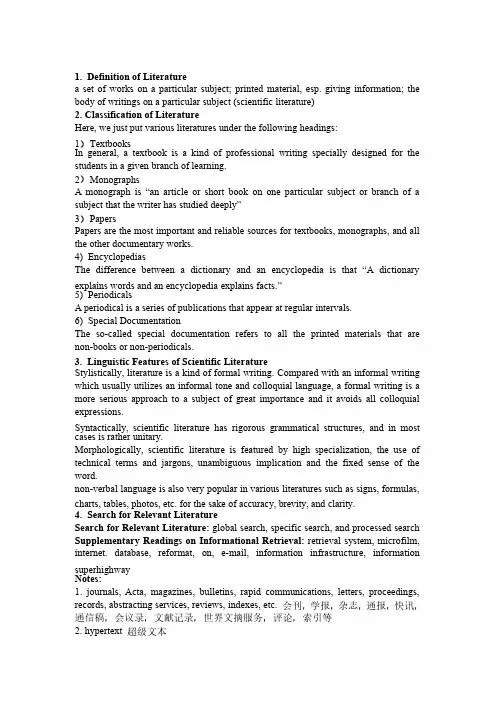
1.Definition of Literaturea set of works on a particular subject;printed material,esp.giving information;the body of writings on a particular subject(scientific literature)2.Classification of LiteratureHere,we just put various literatures under the following headings:1)TextbooksIn general,a textbook is a kind of professional writing specially designed for the students in a given branch of learning.2)MonographsA monograph is“an article or short book on one particular subject or branch of a subject that the writer has studied deeply”3)PapersPapers are the most important and reliable sources for textbooks,monographs,and all the other documentary works.4)EncyclopediasThe difference between a dictionary and an encyclopedia is that“A dictionary explains words and an encyclopedia explains facts.”5)PeriodicalsA periodical is a series of publications that appear at regular intervals.6)Special DocumentationThe so-called special documentation refers to all the printed materials that are non-books or non-periodicals.3.Linguistic Features of Scientific LiteratureStylistically,literature is a kind of formal pared with an informal writing which usually utilizes an informal tone and colloquial language,a formal writing is a more serious approach to a subject of great importance and it avoids all colloquial expressions.Syntactically,scientific literature has rigorous grammatical structures,and in most cases is rather unitary.Morphologically,scientific literature is featured by high specialization,the use of technical terms and jargons,unambiguous implication and the fixed sense of the word.non-verbal language is also very popular in various literatures such as signs,formulas, charts,tables,photos,etc.for the sake of accuracy,brevity,and clarity.4.Search for Relevant LiteratureSearch for Relevant Literature:global search,specific search,and processed search Supplementary Readings on Informational Retrieval:retrieval system,microfilm, internet.database,reformat,on,e-mail,information infrastructure,information superhighwayNotes:1.journals,Acta,magazines,bulletins,rapid communications,letters,proceedings, records,abstracting services,reviews,indexes,etc.会刊,学报,杂志,通报,快讯,通信稿,会议录,文献记录,世界文摘服务,评论,索引等2.hypertext超级文本3.through the Classified and Specified Catalogues通过《分类目录或专题目录》4.through the Newspapers and Journals Indexing通过《全国报刊索引》5.through the Domestic Sci-Tech Data Catalogues通过《国内资料科技目录》6.Sci-Tech Translation Bulletin《科技译文通报》7.the fool collects data and the wise man selects them愚者采集资料,智者选择资料Translation Skills(1):Translation in General and Translation of Special LiteratureTranslation is a rendering of ideas or concepts from one language into another,i.e., the faithful representation in the target language of what is written or said in the original language.A modern society sees an extensive use of translation on various occasions. Proper and dexterous translation helps promote mutual understanding between peoples of different cultural and social backgrounds,whereas improper rendering of words or expressions leads to confusion.Take the ordinary word“menu”for example.Its original meaning is“a list of dishes in a meal or to be ordered as separated meals,esp.in a restaurant”,and the Chinese equivalent seems to be clear:菜单However,when it is used in computer science,its meaning shifts to“a list shown on the display of a computer from which a user can select the operation the computer is to perform.”1.Nature and Scope of TranslationTranslation covers a very broad range.In terms of languages,it can be divided into two categories:from native languages into foreign languages and vice versa;in terms of the mode,it can be divided into oral interpretation and written translation;in terms of materials to be translated,there are translation of scientific materials, translation of literary works such as novels,stories,prose,poetry,drama,etc., translation of political essays such as treatises on social problems,repons,speeches, etc.,and translation of practical writing(as official documents,contracts and agreements,notices,receipts,etc.);in terms of disposal,it can be either full-text translation,abridged translation or adapted translation.2.Principles or Criteria of TranslationThe so-called principles and criteria of translation are actually the two sides of the same coin.That is,on the part of the translator,he or she should follow them while translating;whereas on the part of the reader or critic,he or she may use the principles and criteria to evaluate translation works.Whenever principles or criteria of translation are under discussion in China,Yan Fu’s“three-character guide”--xin,da, ya,namely,“faithfulness(信),expressiveness(达),and elegance(雅)”,which was first proposed in1898,would evoke controversy.In the past decades,Mr.Yan’s principle has always been regarded as a plumb-line for measuring the professional level of translation and a goal for translators to strive after.However,in the application of this principle,people come to find some unsatisfactory aspects of the three-character guide and have put foreword a variety of new standards or criteria of translation.Despite a variety of opinions,two criteria are almost unanimously accepted byall,namely,the criterion of faithfulness/accuracy(忠实/准确)and that of smoothness (流畅).We may also take these two criteria as the principles of scientific literature translation.By faithfulness/accuracy,we mean to be faithful not only to the original contents,to the original meaning and views,but also to the original form and style.By smoothness,we mean not only easy and readable rendering,but also idiomaticexpression in the target language,free from stiff formula and mechanical copying from dictionaries.3.Literal Translation and Free TranslationThe so-called literal translation,superficially speaking,means“not to alter the original words and sentences”;strictly speaking,it strives“to keep the sentiments and style of the original.”For example,crocodile’s tears(鳄鱼的眼泪),armed to the teeth(武装到牙齿),chain reaction(连锁反应),gentlemen’s agreement(君子协定),and so on.Similarly,some Chinese idioms also find their English counterparts through literal translation.For example,纸老虎(paper tiger),一国两制(one country,two systems),and so on.Free translation is an alternative approach which is used mainly to convey themeaning and spirit of the original without trying to reproduce its sentence patterns or figures of speech.Adam’s Apple喉结at sixes and sevens乱七八槽It rains cats and dogs.大雨滂沱Don’t cross the bridge till you get to it.不必担心过早。
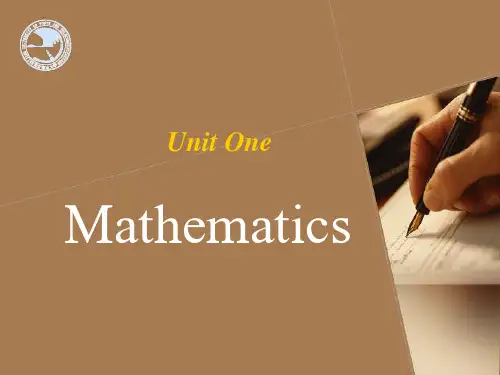
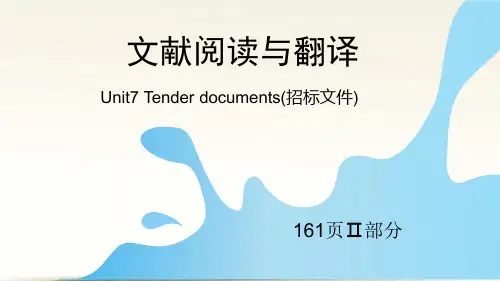
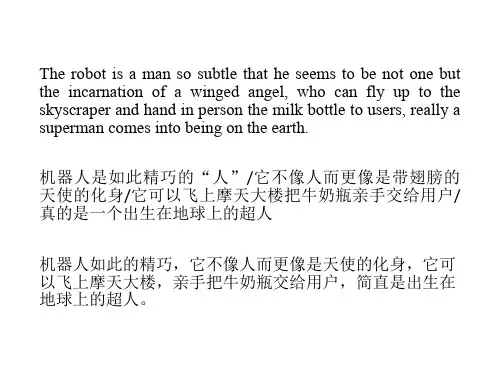
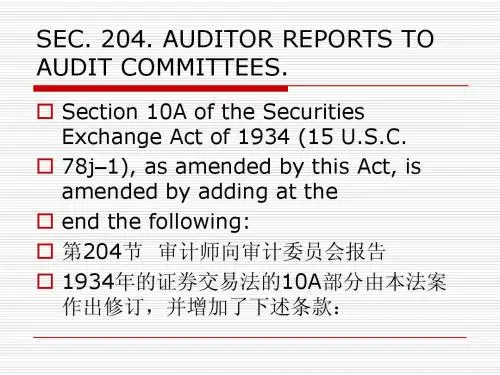
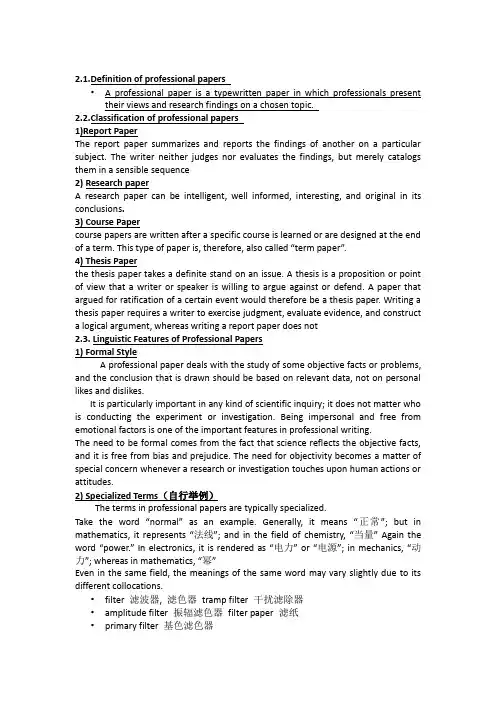
2.1.Definition of professional papers• A professional paper is a typewritten paper in which professionals present their views and research findings on a chosen topic.2.2.Classification of professional papers1)Report PaperThe report paper summarizes and reports the findings of another on a particular subject. The writer neither judges nor evaluates the findings, but merely catalogs them in a sensible sequence2) Research paperA research paper can be intelligent, well informed, interesting, and original in its conclusions.3) Course Papercourse papers are written after a specific course is learned or are designed at the end of a term. This type of paper is, therefore, also called “term paper”.4) Thesis Paperthe thesis paper takes a definite stand on an issue. A thesis is a proposition or point of view that a writer or speaker is willing to argue against or defend. A paper that argued for ratification of a certain event would therefore be a thesis paper. Writing a thesis paper requires a writer to exercise judgment, evaluate evidence, and constructa logical argument, whereas writing a report paper does not2.3. Linguistic Features of Professional Papers1) Formal StyleA professional paper deals with the study of some objective facts or problems, and the conclusion that is drawn should be based on relevant data, not on personal likes and dislikes.It is particularly important in any kind of scientific inquiry; it does not matter who is conducting the experiment or investigation. Being impersonal and free from emotional factors is one of the important features in professional writing.The need to be formal comes from the fact that science reflects the objective facts, and it is free from bias and prejudice. The need for objectivity becomes a matter of special concern whenever a research or investigation touches upon human actions or attitudes.2) Specialized Terms(自行举例)The terms in professional papers are typically specialized.Take the word “normal” as an example. Generally, it means “正常”; but in mathematics, it represents “法线”; and in the field of chemistry, “当量” Again the word “power.” In electronics, it is rendered as “电力” or “电源”; in mechanics, “动力”; whereas in mathematics, “幂”Even in the same field, the meanings of the same word may vary slightly due to its different collocations.•filter 滤波器, 滤色器tramp filter 干扰滤除器•amplitude filter 振辐滤色器filter paper 滤纸•primary filter 基色滤色器What is more, a great number of professional words and terms can only be understood by the specialists in the fields.decoder (译码器), photophor (磷光核), multi-quantum transition (多量子跃迁), Read Only Memory (只读储存器) and conversational implicatures (会话含义),Unit 4Abstracts4.1. Definition of AbstractsAn abstract is a brief and self-contained summary and an accurate representation of the contents of a document such as a research paper, a journal article, thesis, review, conference proceeding, and other academic documents.4.2. Classification of AbstractsIt can be a description of what kind of information it is, which includes the purpose, scope, and methods of the research or it can be the informative content of the document,which includes results and conclusions of the research.如何分类:Depending on which information they contain,abstracts can be classified into major types:indicative abstract informative abstracts,indicative-informative abstract and author abstracts. As they have different aims ,they have different components and styles,4.2.1. Indicative (or descriptive abstracts)An indicative abstract or descriptive abstract is one that describes the type and nature of the work abstracted, indicating the principal subjects covered and providing a brief description of the way the facts are treated and the methods or techniques that are being reported.4.2.2. Informative abstracts4.2.3. Indicative / informative abstracts (综合性)Indicative/ informative abstract is more common than either the pure indicative or the pure information style.4.2.4. Author abstract4.2.5. Slanted abstract4.2.6. Telegraphic abstract4.2.7. Mini-abstract4.2.8 Mission-oriented abstract4.2.9 Finding-oriented abstract4.2.10 Highlight abstract4.3.Linguistic Features of Abstracts4.3.1 Using Topic, Supporting, and Concluding Sentences•An abstract often starts with a “topic” or “lead” sentence. This first sentence attempts to summarize any essential information that is not conveyed by the title. The objective is to enable the reader to eliminate possibly relevant documents, which, in fact, prove to be of little interest without delving into the body of the abstract.4.3.2 Using Brief but Informative SentencesThe abstractor must resist the temptation to use long sentences in striving to avoid repetition.4.3.3 Arranging in One ParagraphAll abstracts, barring possibly those of exceptional length, should consist of one paragraph only. This should be a coherent paragraph, and not a series of disjointed sentences.4.3.4 Being ConciseConciseness is paramount. Redundant phrases such as: “the authors studied”, “in this work”, “the paper concludes by”, etc. should be avoided if possible.4.8. Translation Skills :Technical Terms4.8.1. Affixation•Affixation, which includes prefixation and suffixation, is an important means of coining English technical terms, with prefixes and suffixes as inseparable elements of the words being coined.4.8.2. CompoundingThe combination of two or more words to form a new word is called compounding. English technical terms formed by compounding generally take three forms: with a hyphen or without it, or two or more separate words.4.8.3. Blending•This is a variant of compounding, consisting in omitting the latter part of the first word and clipping off the first part of the second word. Sometimes, however, either the first part or the second part of the overlapped word may happen to be a full word.4.8.4. AcronymsBy acronym, we mean the formation of a word made up of the first letters of the name of something. Since it is very convenient to use this brief form, acronym emerges very frequently in English technical terms.4.8.5. Proper NounsMany of the technical terms in English are borrowed from proper nouns such as names of people, places, firms, trade marks, organizations, and so on. In such cases, consulting relevant dictionaries will be of great help.Unit 5Proposals5.1.Definition of ProposalA proposal is a suggestion or request that some particular action be taken. (A proposal is a written offer to solve a technical problem in a particular way, under a specified plan of management, or for a specified compensation.)三个要素:Tips: written offer to a solve technical problems, specified plan to management , and specified compensation are the main elements of proposal.5.2.Classification of Proposals• 5.2.1. Informal Suggestions• 5.2.2. Semiformal Proposals• 5.2.3 Formal Proposals5.3.Format of ProposalUnit 7Reviews7.1. Definition of Review:A review, as opposed to a survey, should be a critical summary, commentary and literally documented assessment of a work on a specific subject or in a particular field.7.2. Classification of Reviews1) Literature Review•Literature review is written on a particular subject (or a specialty) through analysis, study, synthesis, comment on the basis of extensively referencing professional materials both at home and abroad. It is a kind of comprehensive, summary and commentary article.2) Book Review•Book review is a kind of research writing, an article published in a newspaper or periodical that announces the publication of a new book. It tells what the book is about and evaluates it. The value of a book review depends on the knowledge and ability of the reviewer and on the reviewer's fairness in judging the book. For this reason, the reviewer should have a broad knowledge of the subject of the book under review, the ability to analyze a piece of writing, and the skills to communicate with the reader.7.3. Linguistic Features of Review1) General Contents of Book Reviews• A good book review is always within the scope of three elements: (1) it tells what the book is about, (that is to bring it to the attention of people who may not know of it or may not have considered it properly;) (2) it asserts a judgment of the book's worth,( that is to offer an assessment of its worth and usefulness; and) (3) it defends that judgment. Besides, some reviews undertake to familiarize the reader with the background of the book, (the history of the subject, or the context of issues the book is related to.)2) General Contents of Literature Reviews• A good literature review usually (1) includes the background, the prior work, present disputes, current development and prospect, etc. of the subject the review is about; (2) reveals the author's rigorous and objective comments; (3) provides the reader with a great number of references.只背画横线的部分即可,其他可作为理解。
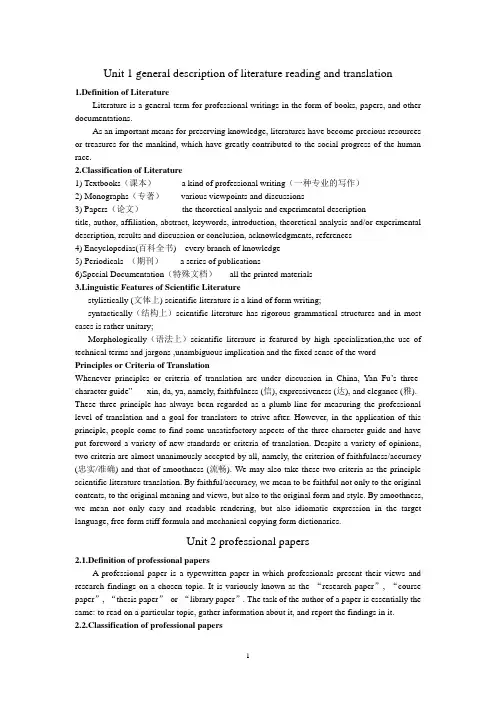
Unit 1 general description of literature reading and translation1.Definition of LiteratureLiterature is a general term for professional writings in the form of books, papers, and other documentations.As an important means for preserving knowledge, literatures have become precious resources or treasures for the mankind, which have greatly contributed to the social progress of the human race.2.Classification of Literature1) Textbooks(课本) a kind of professional writing(一种专业的写作)2) Monographs(专著) various viewpoints and discussions3) Papers(论文) the theoretical analysis and experimental descriptiontitle, author, affiliation, abstract, keywords, introduction, theoretical analysis and/or experimental description, results and discussion or conclusion, acknowledgments, references4) Encyclopedias(百科全书) every branch of knowledge5) Periodicals (期刊) a series of publications6)Special Documentation(特殊文档) all the printed materials3.Linguistic Features of Scientific Literaturestylistically (文体上) scientific literature is a kind of form writing;syntactically(结构上)scientific literature has rigorous grammatical structures and in most cases is rather unitary;Morphologically(语法上)scientific literaure is featured by high specialization,the use of technical terms and jargons ,unambiguous implication and the fixed sense of the wordPrinciples or Criteria of TranslationWhenever principles or criteria of translation are under discussion in China, Yan Fu’s three- character guide”-----xin, da, ya, namely, faithfulness (信), expressiveness (达), and elegance (雅). These three principle has always been regarded as a plumb-line for measuring the professional level of translation and a goal for translators to strive after. However, in the application of this principle, people come to find some unsatisfactory aspects of the three-character guide and have put foreword a variety of new standards or criteria of translation. Despite a variety of opinions, two criteria are almost unanimously accepted by all, namely, the criterion of faithfulness/accuracy (忠实/准确) and that of smoothness (流畅). We may also take these two criteria as the principle scientific literature translation. By faithful/accuracy, we mean to be faithful not only to the original contents, to the original meaning and views, but also to the original form and style. By smoothness, we mean not only easy and readable rendering, but also idiomatic expression in the target language, free form stiff formula and mechanical copying form dictionaries.Unit 2 professional papers2.1.Definition of professional papersA professional paper is a typewritten paper in which professionals present their views and research findings on a chosen topic. It is variously known as the “research paper”, “course paper”, “thesis paper” or “library paper”. The task of the author of a paper is essentially the same: to read on a particular topic, gather information about it, and report the findings in it.2.2.Classification of professional papers1)Report PaperThe report paper summarizes and reports the findings of another on a particular subject. The writer neither judges nor evaluates the findings, but merely catalogs them in a sensible sequence2) Research paperA research paper can be intelligent, well informed, interesting, and original in its conclusions.3) Course Papercourse papers are written after a specific course is learned or are designed at the end of a term. This type of paper is, therefore, also called “term paper”.4) Thesis Paperthe thesis paper takes a definite stand on an issue. A thesis is a proposition or point of view that a writer or speaker is willing to argue against or defend. A paper that argued for ratification of a certain event would therefore be a thesis paper. Writing a thesis paper requires a writer to exercise judgment, evaluate evidence, and construct a logical argument, whereas writing a report paper does not2.3. Linguistic Features of Professional PapersFormal Style: A professional paper deals with the study of some objective facts or problems, and the conclusion that is drawn should be based on relevant data, not on personal likes and dislikes. Specialized Terms:The terms in professional papers are typically specialized. Even in the same field, the meanings of the same word may vary slightly due to its different collections.Take the word “normal” as an example. Generally, it means “iEee”; but in mathematics, it represents “法线”; and in the field of chemistry, “当量” Again the word “power.” In electronics, it is rendered as “电力” or “电源”; in mechanics, “动力”; whereas in mathematics, “幂”Rigid Sentence Structure:The arguments in professional papers will be convincing if they are presented concisely and concretely. A rigid sentence structure is therefore reflected to meet this requirement.Formatted Elements:Though there are no set rules, a complete professional paper in its finished form usually has a regular format composed of the following elements: the title, author(s), affiliation(s), abstract, keywords, introduction, body of the paper (theoretical description including calculation, inference, reasoning, conclusion, etc. or experimental description including techniques, methods, materials, results and analysis, etc.), acknowledgments, appendices, references or bibliography, etc.Different meaning of story(1)This war is becoming the most important story of this generation. Event这场战争将成为这一代人经历的最重大的事件。
学术论文文献阅读与机助汉英翻译IntroductionAs technology advances, artificial intelligence has become an integral part of our lives. With the help of machine learning and natural language processing, machines are not only able to perform routine tasks but are also able to understand, reason and learn. In the translation industry, machine translation has become increasingly popular in recent years.This paper will explore the use of machine translation in translation tasks by reviewing scholarly articles on the topic. Furthermore, we will explore the role of machine translation in automating translation tasks and the impact it has on the translation industry.Advantages of Machine TranslationMachine translation has several advantages in translation tasks. One of the greatest advantages is speed. Machines are able to perform translations in a fraction of the time it would take a human translator. Furthermore, machines can translate large volumes of text quickly and accurately.Another advantage of machine translation is cost. The cost of machine translation is significantly lower than human translation. This is because machines can complete translations without the need for payment, benefits, or time off.Machine translation is also consistent. Machines are not prone tofatigue or errors in the same way humans are. This means that the quality of translations is more consistent and reliable. Disadvantages of Machine TranslationHowever, there are also several disadvantages to using machine translation. One of the biggest disadvantages is accuracy. Machine translation is not always accurate, and can produce errors or awkward translations.Another disadvantage is that machines lack the cultural and linguistic knowledge of a human translator. This means that machines may not be able to properly translate idiomatic expressions or slang.Additionally, machines are not suitable for translations that require a higher level of precision, such as legal or medical translations. This is because these types of translations require a strong understanding of specific terminology and jargon.Research FindingsIn a study conducted by Hasegawa and Kojima (2011), machine translation was compared to human translation for translations of user manuals. The study found that machine translation produced more errors than human translation, and that the quality of machine translation varied widely depending on the source language.On the other hand, a study by Koehn et al. (2003) found that machine translation can produce high-quality translations when thesource text is straightforward and lacks nuanced meaning.Another study by Nitzke and Burchardt (2016) investigated the impact of machine translation on the translation process. They found that machine translation can be a useful tool for translators, but that it is important to take into account factors such as domain, text type, and translation direction.ConclusionMachine translation has several advantages and disadvantages in translation tasks. While it can be useful for translations of certain texts, it is not always accurate and lacks the cultural and linguistic knowledge of a human translator. In conclusion, machine translation has the potential to automate translation tasks and increase efficiency in the translation industry, but cannot replace the role of a human translator entirely.The use of machine translation in the translation industry has been increasing over the years. This is due to the advances in artificial intelligence and natural language processing that have made it possible for machines to understand and translate languages.One of the benefits of machine translation is that it can increase the efficiency of the translation process. This is particularly important for industries that require the translation of large volumes of text. For example, the news media industry relies heavily on machine translation to quickly translate news articles from one language to another. This allows them to deliver news to their audience faster and more efficiently.Moreover, machine translation can also be used in industries such as ecommerce, where the translation of product descriptions can be a time-consuming and costly process. By using machine translation, businesses can translate product descriptions quickly and with greater accuracy, which can lead to increased sales and reduced costs.However, it is important to note that machine translation has limitations. It may not always produce accurate translations, especially when dealing with complex or nuanced texts. In some cases, human translators may be necessary to ensure that the translation accurately captures the meaning and tone of the original text.Furthermore, machine translation can be particularly challenging when translating idiomatic expressions or slang. These types of expressions are often unique to a particular culture or community, and may not have direct translations in other languages. A machine translator may not be able to accurately capture the nuanced meaning of these expressions, resulting in a translated text that may be difficult for the reader to understand.Despite its limitations, there are several ways in which machine translation can be optimized to improve its accuracy and efficiency. One of these methods is by using post-editing, which involves a human translator checking and editing the machine-translated text for accuracy and fluency.Another way is by training the machine translator with domain-specific data. For example, if the machine is being used formedical translations, it can be trained with medical terminology to improve the accuracy of translations in this domain.Additionally, machine translation can also be improved by using a hybrid approach, which combines machine translation with human translation. This approach involves using the machine translator to translate the bulk of the text, then having a human translator edit and refine the translation to ensure accuracy and fluency.Overall, machine translation has become an integral part of the translation industry, and its use is expected to increase in the future. While it has its limitations, it also offers several benefits, such as increased efficiency and reduced costs. With ongoing improvements in artificial intelligence and natural language processing, it is likely that machine translation will become even more advanced, leading to greater accuracy and efficiency in translation tasks.。
Unit Three Reports1. Definition of ReportA report is a form of communication in which the writer gives information to some person or organization because it is his/her responsibility to do so. As this definition indicates, the common element in all reports, which sets them apart as a distinct species, is the element of responsibility.A report may be made by a committee to its parent organization. It may be made by a consultant to a client. It may be made by an individual to his/her superior. It may be short, simple, and intended for a single reader or it may be long, elaborate, and printed at great expense.There are certain kinds of writing so commonly identified as reports that acquaintance with them is valuable. Outstanding examples are recommendation reports, proposals, and progress reports. Others could easily be added to the list: feasibility studies, program evaluations, job descriptions, environmental impact statements. Logically, there are no very clear grounds for designating any of these kinds of writing as reports except when defining “report”, in the most fundamental way possible, as a piece of writing intended to serve some practical purpose.The word report is so neutral that it can mean any type of research paper. A report can be a book review, a critical interpretation of some issue or historical event, a detailed explanation of a scientific experiment, an argument in favor of a political or social program, a comparison of different sets of ideas, or a descriptive essay about a person or place.2. Content of ReportReports are usually expected to include the following:(1) Information or the data that the writer has been able to collect, which may be general or detailed.(2) Calculations which the writer has been able to work out after considering all the data thathe/she has been able to collect.(3) Conclusions at the end of the report in addition to those referred to above. The purpose of the latter is to make it easier for the reader to follow the line of argument the author has chosen, and, if these conclusions are included, they should also be referred to or summarized in the main conclusion division at the end of the report.(4) A recommended course of action, with the recommendations clearly based on the conclusions that the author has previously mentioned.3. Classification of ReportsIf we start with this fundamental definition of report, then the idea of types of reports requires us to find a generally acceptable basis of classification of reports--an attempt at which no one has ever succeeded.Anyway, we may still take the form as the criterion for classifying reports: informal reports, semiformal reports and formal reports. Each of them can be sub- divided into several kinds.3.1 Informal ReportsInformal reports are short, each containing one to three pages of narrative and occasionally attachments such as drawings, photographs, and statistics, etc. Often they are issued in a memorandum or letter form. They generally fall into the following kinds: incident reports, field trip reports, inspection reports, progress reports, and short investigation reports, etc.3.2 Semiformal ReportsSemiformal reports refer to reports of the following kinds: test and laboratory reports, investigation or evaluation reports and suggestions and proposals, etc.3.3 Formal ReportsFormal reports have a much more commanding presence than informal or even semiformalreports. Usually bound within a simple but dignified jacket, they immediately create the appearance of an important document. Internally, their information is compartmentalized and carefully spaced to convey confidence from start to finish.The term formal report refers to the type of document rather than its title and it never appears on the title page. A formal report is more likely to be referred to as a feasibility study, an investigation or evaluation report, a product analysis, or a project report. Sometimes one of these names may precede the report’s main title, but more often the name is omitted and the title stands alone (e.g., the words Evaluation Report or Investigation Report do not appear on the title page.)4. Linguistic Features of Reports4.1 Various PatternsClassified according to their different forms, reports are different in styles and patterns.4.1.1 Letter form reportA letter form report is used when only one point of view needs to be presented and when there is an obvious and probable chronological order for the presentation of the material.4.1.2 Schematic form (图解、概形)reportA schematic form report is diametrically opposed to the letter form, and provided with a clear presentation. The report is written according to a definite scheme and the information or data in it are clearly stated, classified and placed in clearly headed sections of the report.4.1.3 Short report (or Summary report)It is not very different from the pattern of schematic report but is very much shorter than the schematic report.4.1.4 Mixed form reportThe pattern of this report starts off as if it was a letter, but changes to schematic presentationwhen findings are mentioned. It often happens that the scheme followed is no more than numbering the findings and including headings and subheadings as necessary. At the end of the report the author again returns to a letter style.4.2 Self-sufficientA report should be serf-sufficient. That is, anyone who is likely to read it should be able to do so without having to rely on his/her memory or consult his/her files for extra information. This could be achieved by a clear opening of the report, the purpose of which is clearly identified.4.3 More Active VoiceThe pronoun “I” is readily evident in the informal memo reports. Since the reader of a report is normally pre-known by the writer, for example, of a feasibility study report, a progress report, etc., the active voice is usually used instead of the passive in the report.4.4 Clear CitationWhen the material is quoted directly, quotation marks must be used. If words are omitted from a quotation, ellipses (...) should be substituted. If information is quoted indirectly (without quotation marks, as in: President so and so believed that...), the original meaning should be conveyed as exactly as possible. In either case credit should be given to the information source. 4.5 Standard LanguageEvery report has a thesis--or point of view--unless it is purely descriptive, and the writer must make sure that the thesis is supported by the research.The language used is normally not complex but straightforward. It is brief yet fully informative. Avoid cluttering the narrative with unnecessary words and expressions. Present facts clearly and in logical sequence.The conclusion should be general and not too abrupt, and it should follow logically fromwhat has preceded it.5. Search for ReportsInformation on reports can be retrieved from the following sources:5.1 GRA & I RetrievalGRA&I为AD报告,PB报告的检索工具.GRA & I=US Government Reports Announcement and Index(美国政府报告通报和索引)(双周刊)。
目录1外文文献译文 (3)1外文文献原文 (4)2外文文献译文 (7)2外文文献原文 (9)1、外文文献译文《人力资本投资》节选作者:西奥多·威廉·舒尔茨《人力资本投资》---- 简要介绍1960年舒尔茨在美国经济学会年会上发表的题为《人力资本投资》的演说中,对于人力资本观点作了非常系统的论述。
这篇演说震惊了西方整个学术界,这不仅因为舒尔茨一向给人的印象是一位农业经济学家,而且还因为一般人总以为资本是有形的、物质的,至于教育、在职训练、保健、人口流动等方面的投资也可以增加一国资本存量和加速经济发展的观念对于当时的经济学界来说的确是很新鲜的。
这次会议之后,人力资本成为经济学中一个非常热门的新兴领域,“人力资本”也成了西方教育经济学的基本概念,人力资本理论成为现代西方资产阶级发展经济学的一个主要学派。
《人力资本投资》---- 内容提要舒尔茨这篇《人力资本投资》被人称之为:人力资本研究新领域的“独立宣言”,其在文中提出了九项主张:“在税收政策上应该给人力资本给予优惠;防止人人力资本的闲置和老化;避免对人力资本投资进行人为的干扰;完善人力资本市场,银行应积极主动地提供人力资本所需的费用,鼓励私人和公共投资;政府应承担人力资本投资的大部分费用,特别是资助劳动力向城市转移;重视低收入者的人力资本投资;明确教育和保健同样具有经济意义,它们是一项投资,要扭转投资在这方面的不平衡;增加政府投入、扩大人力资本投资,以减少收入的不平等;舒尔茨所提出的人力资本理论的基本内涵是:把资本分为物质资本和人力资本两种形式。
人力资本是体现在劳动者身上的以劳动者的数量和质量表示的资本。
劳动者的知识、技术水平、劳动技能的高低不同,决定了人力资本对经济的生产性作用的不同,结果使国民收入增长的程度也不同。
舒尔茨的人力资本理论有五个主要观点:(一)人力资本存在于人的身上,表现为知识、技能、体力(健康状况)价值的总和。
一个国家的人力资本可以通过劳动者的数量、质量以及劳动时间来度量。
英文文献:The application of e-commerce for SMEsA great advantage of e-commerce is not only suitable for use in large enterprises, but also very beneficial to many small and medium enterprises. Relative to large enterprises, small and medium enterprises of human, financial, information technology, weak and small and medium enterprises to apply e-commerce is a new topic to be studied. Typically, the use of e-commerce has four types: information access, personal communication, shopping services, virtual enterprises.As e-commerce is a complex system engineering, it will use many new technologies, but the most important thing is the following: Electronic Data Interchange (EDI), bar codes, e-mail, Internet, WorldWideWeb, product data exchange and electronic form. The benefits of e-commerce use by SMEsFor small and medium sized e-commerce can give them to bring many new opportunities and challenges facing SMEs it can solve many difficulties and problems. The arrival of Internet for SMEs to open up a broader market space. As the information in the enterprise's competitive edge competitive play an increasingly important role, with e-commerce, information on SMEs and big business competition. Overall, the impact of electronic commerce for small and medium enterprises can be divided into the following areas: 1. Global markets, the competitiveness of SMEs traditional market can be strengthened; SMEs have more opportunities to sell the products to various countries and regions worldwide. 2. Market supply chain suppliers to provide design and engineering services required will increase; manufacturers will outsource more non-core businesses; customers will need more electronic communication for use in orders, billing and other business, when large customers that request, which will have a big impact the supply chain; customers will require their suppliers to provide more inventory management services, such as data warehouse and order management; manufacturers will continue to reduce the total number of suppliers; supply chain links between the companies will more closely. 3. Internal operations and process control with greater use of networked information technology and system integration technology, the company will improve communications and collaboration; will use more automated manufacturing technology for integrating external data and internal operations to provide greater opportunities, such as EDI and MRP systems integration; enterprises will reduce the number of employees, but will increase the workload of each employee; business operationsand management costs will be reduced.4. Customer service providers will try to shorten the manufacturing of new products and services of their available time; manufacturers will try to minimize the price; product quality will be greater attention; suppliers will find a need for faster and better to provide order status information (such as the production date); businesses will pay more attention to the product after-sales service; information and telecommunications services, competition will intensify between; available to manufacturers of information and the types of telecommunications services will increase; The new e-commerce products and services will appear; human resources and work structure; computer's role in the enterprise will become more important; small company in training employees to use computers, the more difficult than those of large companies. 5. Information as business assets, the information itself will become an important marketable commodities (such as databases); company data in decision-making will play an important role; through networking, manufacturers will have more and better opportunities to access more widely useful in commercial and technical information. 6. Small business prospects and timely use of the network can access the latest business trends information to guide their production and sales. Determine the feasibility of e-commerce technology When SMEs decide to use e-commerce, it is necessary to meet these business needs to determine the technical feasibility of the various e-business initiatives. A basic principle is to use the most it can increase the operational capacity of e-commerce technology. Here are the most suitable technology for each number of e-commerce applications, can be used for small and medium enterprises in the choice of reference. 1.EDI the structured data into other Yingyong in (such as the use of customer orders to install the product); when the transaction volume can reduce costs; allow the trading of many Butong Huoban (such as customers, suppliers, manufacturers, etc.) trade between easier.2. Barcodes quickly determine and identify the merchandise; to determine the identity and integration into other applications and databases.3. E-mail to individuals or groups to provide free inquiry and exchange; need to send some simple information sharing to all members of the enterprise; by additional document (attachment) to share complex information; to make long-distance collaboration faster and more convenient.4.WorldWideWeb published information about the company to achieve the purpose of publicity companies; from a large number of data sources to retrieve information; e-commerce to buy / sell goods or services; collaboration between multiple users or information sharing.5. Product data exchange needs to be timely productinformation sent to trading partners; distance together with partners in product design.6. Spreadsheet better way to format a norm concerning the management of data; when it comes to many different tasks simultaneously can track the entire process; artificial input data with data on the machine itself is integrated with; by integration of WWW and the implementation of internal systems to facilitate electronic commerce.Several issues should be notedRelative to large enterprises, small and medium enterprises in human, financial, information technology, weaker, and therefore the process of implementing e-commerce there are some issues warrant particular attention, even small enterprises need on the e-commerce system level of view, this process is very important.When companies feel the need of enterprise systems from anywhere in the process started e-commerce can make use of existing commercial enterprises or technology, you can also e-business from scratch for system-level planning and design. If the enterprise may resolve how to deal with excess inventory when the thought of starting e-commerce, while another company might choose through the implementation of e-commerce strategies to improve customer service levels. This is the advantage of a flexible small and medium enterprises, and large enterprises is different, in order to conduct e-commerce system-level on the need for comprehensive planning. For small and medium terms, system-level programs can also be achieved at various stages of e-commerce start. Even if some companies have implemented e-commerce systems can also be quickly modified.For e-commerce may return to the business benefits to be in the business consequences and evaluate the technical feasibility of both. These two aspects will affect the implementation of e-business attitude and determination. One pair of their competition in the market its ability to company not necessarily can do it well the new e-commerce technology,While the other wants to use the new e-commerce tools to expand their competitive advantage of companies, the pace of implementation of e-commerce may be larger.Because electronic commerce is a systematic project, required before the decision to use it make sure to do so can give enterprises the greatest benefits and minimum adverse effects, most important is to ensure the implementation of e-commerce can bring to the moreenterprise of interest returns.中文翻译:中小企业如何应用电子商务电子商务的一个很大的优点是它不仅适合于大企业使用,而且对众多的中小企业也非常有利。
Translation skills (2): DictionBy “diction” we mean the proper choice of words and phrases in translation on the basis of accurate comprehension of the original.通过用词,我们意味着在准确理解原义基础上的翻译中选择合适的短语和词组。
In the practice of translation, what perplexes a translator most is how to find the equivalents in the language to be translated into. Great care is called for in the translation of “familiar” English words into Chinese, as their meanings vary with the change in collocation 排列or context. Take the following simple sentence for example: 在翻译的实践中,使译者最为困惑的如何在译文中找到替换词。
Tension is building up.Without a given context, both “tension” and “build up” may have various explanations. Thus this simple English sentence can be translated into different Chinese versions:(1)形式紧张起来。
(2)张力在增大。
(3)电压在增加。
(4)压力在增强。
(5)……As regards this phenomenon, a noted British philosopher puts it very well: “The meaning of a word is its use in the language.” A noted British linguist puts it even bluntly: “Each word, when used in a new context, is a new word.”In comparison with Chinese, English words are more flexible both in form and in meaning: English words of different parts of speech often assume different forms and the meaning of each word mainly depends on the context. Therefore it is often a hard task for a translator to find the Chinese equivalent of a given English word. Take the word “story” for example:(1)This war is becoming the most important story of this generation.(2)It is quite another story now.(3)Some reporters who were not included in the session broke the story.(4)He’ll be very happy if that story holds up.(5)The Rita Haywoth story is one of the saddest.(6)A young man came to Scotti’s office with a story.Each of the six “story” here manifests its own connotation. In sentence(1)it refersto “event”;(2) “situation”;(3) “inside information”;(4) “statement”;(5) “experience”;(6) “law case.” And therefore, the corresponding Chinese versions are:(1)这场战争将成为这一代人经历的最重大的事件。
Unit 1 general description of literature reading and translation1.Definition of LiteratureLiterature is a general term for professional writings in the form of books, papers, and other documentations.As an important means for preserving knowledge, literatures have become precious resources or treasures for the mankind, which have greatly contributed to the social progress of the human race.2.Classification of Literature1) Textbooks(课本) a kind of professional writing(一种专业的写作)2) Monographs(专著) various viewpoints and discussions3) Papers(论文) the theoretical analysis and experimental descriptiontitle, author, affiliation, abstract, keywords, introduction, theoretical analysis and/or experimental description, results and discussion or conclusion, acknowledgments, references4) Encyclopedias(百科全书) every branch of knowledge5) Periodicals (期刊) a series of publications6)Special Documentation(特殊文档) all the printed materials3.Linguistic Features of Scientific Literaturestylistically (文体上) scientific literature is a kind of form writing;syntactically(结构上)scientific literature has rigorous grammatical structures and in most cases is rather unitary;Morphologically(语法上)scientific literaure is featured by high specialization,the use of technical terms and jargons ,unambiguous implication and the fixed sense of the wordPrinciples or Criteria of TranslationWhenever principles or criteria of translation are under discussion in China, Yan Fu’s three- character guide”-----xin, da, ya, namely, faithfulness (信), expressiveness (达), and elegance (雅). These three principle has always been regarded as a plumb-line for measuring the professional level of translation and a goal for translators to strive after. However, in the application of this principle, people come to find some unsatisfactory aspects of the three-character guide and have put foreword a variety of new standards or criteria of translation. Despite a variety of opinions, two criteria are almost unanimously accepted by all, namely, the criterion of faithfulness/accuracy (忠实/准确) and that of smoothness (流畅). We may also take these two criteria as the principle scientific literature translation. By faithful/accuracy, we mean to be faithful not only to the original contents, to the original meaning and views, but also to the original form and style. By smoothness, we mean not only easy and readable rendering, but also idiomatic expression in the target language, free form stiff formula and mechanical copying form dictionaries.Unit 2 professional papers2.1.Definition of professional papersA professional paper is a typewritten paper in which professionals present their views and research findings on a chosen topic. It is variously known as the “research paper”, “course paper”, “thesis paper” or “library paper”. The task of the author of a paper is essentially the same: to read on a particular topic, gather information about it, and report the findings in it.2.2.Classification of professional papers1)Report PaperThe report paper summarizes and reports the findings of another on a particular subject. The writer neither judges nor evaluates the findings, but merely catalogs them in a sensible sequence2) Research paperA research paper can be intelligent, well informed, interesting, and original in its conclusions.3) Course Papercourse papers are written after a specific course is learned or are designed at the end of a term. This type of paper is, therefore, also called “term paper”.4) Thesis Paperthe thesis paper takes a definite stand on an issue. A thesis is a proposition or point of view that a writer or speaker is willing to argue against or defend. A paper that argued for ratification of a certain event would therefore be a thesis paper. Writing a thesis paper requires a writer to exercise judgment, evaluate evidence, and construct a logical argument, whereas writing a report paper does not2.3. Linguistic Features of Professional PapersFormal Style: A professional paper deals with the study of some objective facts or problems, and the conclusion that is drawn should be based on relevant data, not on personal likes and dislikes. Specialized Terms:The terms in professional papers are typically specialized. Even in the same field, the meanings of the same word may vary slightly due to its different collections.Take the word “normal” as an example. Generally, it means “iEee”; but in mathematics, it represents “法线”; and in the field of chemistry, “当量” Again the word “power.” In electronics, it is rendered as “电力” or “电源”; in mechanics, “动力”; whereas in mathematics, “幂”Rigid Sentence Structure:The arguments in professional papers will be convincing if they are presented concisely and concretely. A rigid sentence structure is therefore reflected to meet this requirement.Formatted Elements:Though there are no set rules, a complete professional paper in its finished form usually has a regular format composed of the following elements: the title, author(s), affiliation(s), abstract, keywords, introduction, body of the paper (theoretical description including calculation, inference, reasoning, conclusion, etc. or experimental description including techniques, methods, materials, results and analysis, etc.), acknowledgments, appendices, references or bibliography, etc.Different meaning of story(1)This war is becoming the most important story of this generation. Event这场战争将成为这一代人经历的最重大的事件。